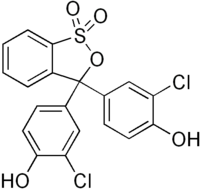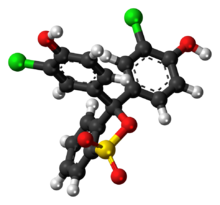Chemistry:Chlorophenol red

| |

| |
| Names | |
|---|---|
| Preferred IUPAC name
3,3-Bis(3-chloro-4-hydroxyphenyl)-2,1λ6-benzoxathiole-1,1(3H)-dione | |
| Other names
3′,3′-Dichlorophenolsulfonaphthalein
| |
| Identifiers | |
3D model (JSmol)
|
|
| ChemSpider | |
| EC Number |
|
PubChem CID
|
|
| UNII | |
| |
| |
| Properties | |
| C19H12Cl2O5S | |
| Molar mass | 423.26 g·mol−1 |
| Melting point | 261 °C (502 °F; 534 K)[1] |
Except where otherwise noted, data are given for materials in their standard state (at 25 °C [77 °F], 100 kPa). | |
| Infobox references | |
| Chlorophenol red (pH indicator) | ||
| below pH 5.4 | above pH 6.8 | |
| 5.4 | ⇌ | 6.8 |
Chlorophenol red is an indicator dye that changes color from yellow to violet in the pH range 5.4 to 6.8.[2] The pH of a substance is determined by taking the negative logarithm of the Hydronium ion concentration and the indictor changes color due to the dissociation of H+ ions.[3] The lambda max is at 572 nm.[4]
Properties and uses
The dissociation mechanism of chlorophenol red is similar to that of phenolphthalein meaning it can be used as a color indicator. The dissociation of hydroxyl and hydrogen atoms creates the dissociate scheme of chlorophenol red to change color from yellow to red.[5] The pH properties of chlorophenol red are used to selectively determine the amount of chlorine dioxide in drinking water. Chlorophenol red selectively reacts with 0.1–1.9 mg/L chlorine dioxide at pH 7. [6] The electrochemical properties of Chlorophenol red allows it to be a chromogenic label and can undergo oxidation creating several phenolic intermediates. The bacterial hydrolysis of a chlorophenol red labelled substrate produces chlorine retaining intermediates on electrodes. [7]
References
- ↑ Haynes, p. 3.116
- ↑ Haynes, p. 8.88
- ↑ "pH Indicators" (in en). 2013-10-02. https://chem.libretexts.org/Bookshelves/Physical_and_Theoretical_Chemistry_Textbook_Maps/Supplemental_Modules_(Physical_and_Theoretical_Chemistry)/Acids_and_Bases/Acid_and_Base_Indicators/PH_Indicators.
- ↑ "Chlorophenol Red". https://www.sigmaaldrich.com/catalog/product/aldrich/199524.
- ↑ Hanai, Toshihiko (2016). "Quantitative Evaluation of Dissociation Mechanisms in Phenolphthalein and the Related Compounds.". Journal of Computer Chemistry 15: 13–21. https://www.researchgate.net/publication/301942181.
- ↑ Sweetin, Deborah L.; Sullivan, Elizabeth; Gordon, Gilbert (1996-01-01). "The use of chlorophenol red for the selective determination of chlorine dioxide in drinking water". Talanta 43 (1): 103–108. doi:10.1016/0039-9140(95)01721-6. PMID 18966469.
- ↑ Casimero, Charnete; Bigham, Teri; McGlynn, Ruairi J.; Dooley, James S. G.; Ternan, Nigel G.; Snelling, William J.; Critchley, Megan E.; Zinkel, Cameron L. et al. (2019-12-01). "Electroanalytical properties of chlorophenol red at disposable carbon electrodes: Implications for Escherichia coli detection". Bioelectrochemistry 130: 107321. doi:10.1016/j.bioelechem.2019.06.006. PMID 31306878.
Cited sources
- Haynes, William M., ed (2016). CRC Handbook of Chemistry and Physics (97th ed.). CRC Press. ISBN 9781498754293.
 |

